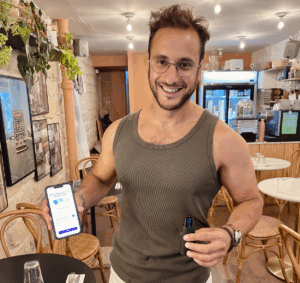After the advent of home meal delivery pushed by the health crisis, the home delivery market seems to encounter some snags from the point of view of certain restaurateurs. The multiplication of supply in the face of not necessarily very mature demand, the return of customers to stores and the economic crisis are possible explanations for the drop in volumes.
If this market is growing on the consumer side, the question arises of the fragmentation of demand in the face of a supply that is saturated to say the least.
A brief historical overview of what has happened in the ruthless world of food since the start of 2019.
From local know-how to the marketplace
Originally, meal delivery was a matter for experts. From Domino's to Planet Sushi and the independents, those who have been doing delivery for around twenty years have made it a specialty, with real know-how, from preparing dishes to delivery.
By Uberizing delivery, marketplaces broke down certain barriers to entry, but delivery still remained a domain for insiders. Until the health crisis, which literally pushed the majority of restaurants to register on delivery platforms, breaking down all barriers to entry, and creating a market without borders.
Do you have a business and want to regain control of your margins and your business model? Discover my solution Ultimate Business Dashboard which transforms your raw accounting data into performance indicators and a monthly dashboard.
Worse still, it is not only “all” restaurants that have registered on these platforms, but also “ghost brands”, that is to say virtual brands that each restaurant could create in order to amortize its materials. firsts.
Not to mention “template franchises”, that is to say entirely virtual brands sold by franchisors to restaurateurs, who only have to do the assembly, and who must pay an additional commission to the franchisor for the whole marketing aspect.
If these virtual brands aim to become big players in food, why not. But most will have been “disposable brands”, which rather than creating emulation, cannibalized an already unprofitable market.
From the illusion of choice to Pareto
What was supposed to happen, happened: customers had an almost unlimited choice on these platforms, which led to extremely tough competition between the “operators” (that is, restaurateurs…).
This reminds us of Schumpeterian theories according to which supply adapted to demand, but not only did it adapt late, but much too quickly compared to demand. In other words, there are too many restaurants, and especially too many restaurants offering the same offer, for not enough customers.
As a result, the homo œconomicus did not necessarily look from noon to 2 p.m. to make his choice, the idea being for him to find the best quality/calorie/price/speed of execution ratio.
This new paradigm has benefited the most financially solid brands to ensure a sufficient quantity of calories at a reasonable price, therefore often unhealthy or simply at a loss.
Added to this was government aid, which did not fail to give EPO to restaurants, thus creating a fool's market.
After the health crisis, and until today, it could be that it is the big players who, like the Pareto model, have recruited the majority of customers, to the detriment of the small players, who nevertheless continue to generate small volumes as a bonus and visibility.
In the end, e-delivery has only reproduced the reality of the physical market, in the digital world: previously, we queued at McDonald's to order, and we ate willy-nilly on the spot, standing up or in the park opposite the university or high school. Today, we order from home, working from home, and we send an army of delivery people to collect our package, with all that that implies on a social, ecological and urban level.
On the desertion of city centers
Before, to have the luxury of staying at home for several days to work, you had to have both time and cooking skills. Otherwise, we were lucky enough to live more or less in the city center, and we would go get a sandwich, drink a coffee and chat with the local florist.
Today, the democratization of teleworking, and access to food via delivery platforms – and dark kitchens – have had enormous consequences on local commerce, and we are witnessing in a Darwinian way bankruptcies in cascade, particularly in office districts where food businesses had set up to feed employees. Why bother going to the office if you can work and eat from home?
Except that in the meantime, after having indirectly “killed” local commerce, the online delivery of prepared meals also seems to be facing a crisis…
The sprinkler watered
As with VTCs, marketplaces have had to revise their prices upwards once they are well established in cities and customs. So, to afford a simple burger and fries drink, we went from an average basket of €12 3 years ago, to €19 and sometimes even €22.
Indeed, if most restaurateurs previously sacrificed their margin by thinking of participating in the gold rush, they quickly revised their prices upwards, and the marketplaces as well, for the sake of profitability.
With rising prices, the economic crisis, and the multiplication of supply, customers can no longer keep up as much as before, and can no longer order everything and anything every day. As a result, volumes on the restaurant side quickly fell again, and the fantasized growth is for the moment only an old memory.
Conversely, we have seen a good number of customers return to stores, with the explosion of what I call foodtertainment , namely the act of transforming a simple restaurant into an amusement park. Thanks to Instagram, in the era of immersive, “all visual” and “social proof”, many concepts capitalize on unique products, in a unique atmosphere, with strong viral power, from NY rolls to Chinese noodles to “pizzas like in Italy”.
We thus went from functional bistro cuisine (and later casual food) to recreational cuisine, which makes full use of the TikTok and Insta algorithms, but no longer the Deliveroo and UberEATS algorithm.
Hangover
A good number of players have therefore logically left the dark kitchens, burned by commissions which have never been revised downwards, and volumes that are too low. Others have raised their prices, cutting themselves off from many customers.
As a reminder, a restaurant's margin is approximately between 20 and 30%, but each order that is delivered via a marketplace is reduced by 30% by the marketplace. Increasing prices to cover this commission is not a panacea either, because it lowers volumes, makes customers much more demanding, less loyal and leaves them with a less positive memory of the brand ordered. In addition, the commission is not a fixed fee, it also applies to the increased part of the price, which does not help matters.
If restaurants want to continue to exist online, I don't see 36,000 solutions.
Towards a “luxury” offer?
They must therefore choose between two possible offers: either a low-end street food with very low production costs, but well marketed, with well-polished photos, in order to justify a correct selling price to cover costs, and all aimed at very young people, a very premium offer, with a fairly high-quality meal, reserved for an urban elite, ready to frequently spend between €20 and €30 per meal.
The problem with the first option is that if you are not “in the hype”, your selling price will quickly be considered unjustified. With the second option, you will have to address niches which have good purchasing power and which embrace your offer because they adhere to your philosophy (example: healthy, gluten-free, protein dishes, vegan burgers, etc. …).
But in both cases, there will not be room for all the players in this very unprofitable market. Which makes me say that in the end, despite all the agitation around the rise of street food and the current diversification of the offer, it is possible that in terms of market leaders, we will come back the basics: burger, pizza, sushi.





